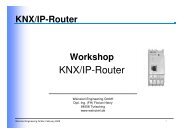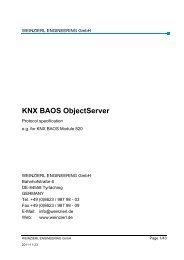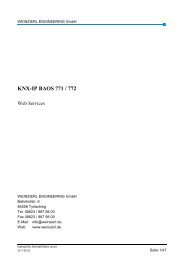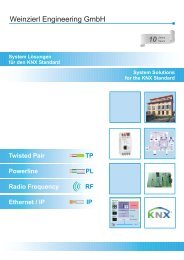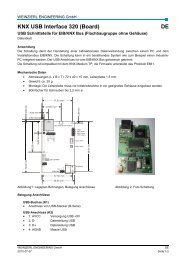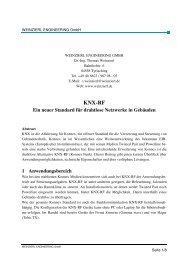KNX over IP - Weinzierl Engineering GmbH
KNX over IP - Weinzierl Engineering GmbH
KNX over IP - Weinzierl Engineering GmbH
You also want an ePaper? Increase the reach of your titles
YUMPU automatically turns print PDFs into web optimized ePapers that Google loves.
WEINZIERL ENGINEERING <strong>GmbH</strong><br />
WEINZIERL ENGINEERING GMBH<br />
F. Heiny, Dr. Th. <strong>Weinzierl</strong><br />
Bahnhofstr. 6<br />
DE-84558 Tyrlaching<br />
Tel. +49 (0) 8623 / 987 98 - 03<br />
Fax +49 (0) 8623 / 987 98 - 09<br />
E-Mail info@weinzierl.de<br />
<strong>KNX</strong> <strong>over</strong> <strong>IP</strong><br />
New Solutions for <strong>KNX</strong> Installations<br />
Introduction<br />
While <strong>KNX</strong> has grown into the most important building automation standard, Ethernet has<br />
evolved into a universal communications solution that can also be employed in automation<br />
systems. Because of their different system characteristics, <strong>KNX</strong> and Ethernet complement each<br />
other well.<br />
Photo: <strong>KNX</strong> <strong>IP</strong> LineMaster 760<br />
The advantages of the <strong>KNX</strong> bus are in the optimal adjustment of the <strong>KNX</strong> system to the special<br />
requirements of building control. Over a single twisted pair wire devices are not only networked<br />
but also supplied with energy. The relatively low bandwidth of 9600 bits per second is sufficient<br />
WEINZIERL ENGINEERING <strong>GmbH</strong> EN<br />
2011-01-31 Page 1/9
<strong>KNX</strong> <strong>over</strong> <strong>IP</strong><br />
for the communication within a bus line, but allows long cable lengths and a free topology. At<br />
the same time reduces the low transmission speed the energy consumption of devices because<br />
the power consumption of microcontroller depends heavily on the clock rate. <strong>KNX</strong> twisted pair is<br />
easy and inexpensive to install, because the bus can be looped from one participant to the next<br />
without a hub or switch through. Not least however, <strong>KNX</strong> devices are functionally and<br />
mechanically designed specifically for building installations.<br />
The decisive advantage of Ethernet is in its high bandwidth at relatively low cost for components<br />
and its very widespread use. Today Ethernet is not only used for networking computers in the<br />
office, but also for multimedia applications in the home and for industrial automation.<br />
Despite, and indeed because of, the high transmission speeds, LAN networks cannot replace<br />
the <strong>KNX</strong> bus. Instead, the combination of <strong>KNX</strong> TP and LAN provides an optimal solution for<br />
future building automation. <strong>KNX</strong> TP is primarily suited for local control, while the LAN is used for<br />
inter-system communication. The transmission of control commands can take place in a LAN<br />
network together with Internet use, PC networking and multimedia. Overall, this results in a<br />
hierarchical architecture for building networking.<br />
Tunneling: PC access via a LAN connection<br />
An important application of <strong>IP</strong> within the <strong>KNX</strong> system is the functionality of an interface to the<br />
bus. <strong>KNX</strong>net/<strong>IP</strong> tunneling describes the access, for example, from a PC to a <strong>KNX</strong> network<br />
during the configuration and commissioning. The focus is always the connection of a client (PC)<br />
with a bus line. The tunneling protocol only uses UDP, but includes a security layer, so that<br />
telegrams will be repeated in case of error.<br />
Usage of the <strong>KNX</strong>net/<strong>IP</strong> Standard Tunneling Photo: <strong>KNX</strong> <strong>IP</strong> Interface 730<br />
The tunneling protocol can be selected in the Connection Manager of the ETS program and is<br />
also suitable for remote access <strong>over</strong> the Internet. It also can be used to connect a visualization<br />
device to a bus line. The tunneling protocol supports the busmonitor function.<br />
WEINZIERL ENGINEERING <strong>GmbH</strong> EN<br />
2011-01-31 Page 2/9
<strong>KNX</strong> <strong>over</strong> <strong>IP</strong><br />
Routing in hierarchical architectures<br />
A major motivation for the extension of the <strong>KNX</strong> system using Ethernet/<strong>IP</strong> was to increase the<br />
transmission capacity of the <strong>over</strong>all system. While the transmission speed of <strong>KNX</strong> twisted pair is<br />
fully adequate to build a bus line with up to 256 participants, a much higher bandwidth may be<br />
needed in the backbone. This is especially the case when central devices such as visualization<br />
tools are connected, to which all telegrams need to be transferred. In this case, there can be no<br />
selective routing.<br />
Usage of the <strong>KNX</strong>net/<strong>IP</strong> Standards Routing Photo: <strong>KNX</strong> <strong>IP</strong> Router 750<br />
Here, the high bandwidth of a LAN network offers an optimal solution. While with <strong>KNX</strong> TP a<br />
maximum of only 50 telegrams can be transmitted per second, transmission via LAN exceeds<br />
10,000 telegrams at 10 MBit/s. To process this traffic without loss, high computational power in<br />
addition to an adequate telegram buffer from <strong>IP</strong> to <strong>KNX</strong> TP is required.<br />
Since Ethernet is of great significance as the backbone for the system, a corresponding protocol<br />
was standardized in <strong>KNX</strong>. The Routing subtopic of the <strong>KNX</strong>net/<strong>IP</strong> specification describes how<br />
<strong>KNX</strong>/<strong>IP</strong> Routers forward telegrams via <strong>IP</strong>. For forwarding via Ethernet, the <strong>KNX</strong> telegrams are<br />
individually packed in UDP/<strong>IP</strong> telegrams and sent as multicast telegrams. All <strong>KNX</strong>/<strong>IP</strong> routers in<br />
the network receive these telegrams simultaneously and use their routing tables to determine<br />
whether to forward the telegram into the connected <strong>KNX</strong> line.<br />
The routing protocol can be used to connect an unlimited number of visualization devices to a<br />
<strong>KNX</strong> installation with <strong>IP</strong> backbone but does not support the busmonitor functionality.<br />
Object server: From the telegram to the data point<br />
For an increasing number of devices, such as in the areas of multimedia and security<br />
technology, the exchange of control information with the building automation is of significance.<br />
However, for certain devices it is preferable to not access the bus directly. Instead, a connection<br />
can be established to the <strong>KNX</strong> via Ethernet. Communication via Ethernet is particularly<br />
interesting for devices that are already equipped with a network port. If the protocol stack for<br />
WEINZIERL ENGINEERING <strong>GmbH</strong> EN<br />
2011-01-31 Page 3/9
<strong>KNX</strong> <strong>over</strong> <strong>IP</strong><br />
TCP/UDP/<strong>IP</strong> already exists in the operating system, applications can communicate with other<br />
devices via Ethernet with little additional effort and thus also with <strong>KNX</strong>. This applies to many<br />
devices based on Linux or Windows CE.<br />
Typical Application of the <strong>KNX</strong> <strong>IP</strong> BAOS<br />
If you were to use tunneling or routing as a solution, the devices would be able to access the<br />
<strong>KNX</strong> network but would still have to generate and interpret <strong>KNX</strong> telegrams.<br />
It is far simpler for the <strong>KNX</strong>/<strong>IP</strong> interface to take <strong>over</strong> this task. In addition to the standard<br />
interface functionality, which enables access to the <strong>KNX</strong> bus on the telegram level, the <strong>KNX</strong> <strong>IP</strong><br />
BAOS is an Object Server and provides direct access to the data points (communication<br />
objects) of the building. That is, the <strong>KNX</strong> stack in the device assigns the received data packets<br />
to their associated communication objects and holds their values in memory. Registered clients<br />
are automatically informed of any changes to the data points.<br />
The communication object values are automatically updated upon receipt, even when clients<br />
are not connected. This allows, for example, a Smartphone to instantly access the state of the<br />
<strong>KNX</strong> bus from the BAOS device, without loading the network with a burst of read requests.<br />
In order to send data to the bus, a client has write access to the communication objects. The<br />
device can independently generate and send group messages.<br />
The configuration of the data points within the BAOS device is performed with the ETS<br />
(<strong>Engineering</strong> Tool Software). In the ETS the device appears as a conventional bus participant.<br />
Within the parameters dialog, the data types of the communication objects can be set and the<br />
group addresses are assigned as usual.<br />
WEINZIERL ENGINEERING <strong>GmbH</strong> EN<br />
2011-01-31 Page 4/9
<strong>KNX</strong> <strong>over</strong> <strong>IP</strong><br />
Usage of the Object Server protocol Photo: <strong>KNX</strong> <strong>IP</strong> BAOS 771<br />
Using the BAOS protocol a client can access and control data points of other bus participants<br />
without having to know the encoding of <strong>KNX</strong> telegrams. The client addresses the data points on<br />
the same number that they have in the ETS. If the group addresses in the <strong>KNX</strong> network are<br />
modified the interface can be updated automatically by an ETS download, and the client<br />
application can remain unchanged. The <strong>KNX</strong> <strong>IP</strong> BAOS 771/772 offers two separate client<br />
access protocols:<br />
Binary Protocol<br />
The device supports an extension of the <strong>KNX</strong> BAOS binary protocol that is implemented by the<br />
BAOS 770 (Protocol Version 1). The <strong>KNX</strong> <strong>IP</strong> BAOS 771/772 device implements Protocol<br />
Version 2.0, an improved version. It is available <strong>over</strong> TCP/<strong>IP</strong> and UDP/<strong>IP</strong>. The binary protocol is<br />
particularly suitable for devices that support traditional programming languages like C, C++ or<br />
C# and <strong>IP</strong> sockets.<br />
Web Services<br />
The <strong>KNX</strong> BAOS Binary Protocol typically precludes the development of client applications that<br />
run in a Web Browser. For this reason access to the Object Server is now possible via the new<br />
<strong>KNX</strong> BAOS Web Services, based on HTTP and Java Script Object Notation (JSON). This<br />
means it is now possible to embed <strong>KNX</strong> <strong>IP</strong> BAOS 771/772 directly in your own Web<br />
applications.<br />
The Web Services offer the same feature set as <strong>KNX</strong> BAOS binary protocol, however use a<br />
familiar text-based syntax that is sent <strong>over</strong> HTTP (port 80). The Web Services do not implement<br />
a graphical interface. This must be done separately, typically in HTML and Java Script, and can<br />
be stored, for example, in client memory, or wrapped directly into a stand-alone application<br />
using Webkit.<br />
WEINZIERL ENGINEERING <strong>GmbH</strong> EN<br />
2011-01-31 Page 5/9
<strong>KNX</strong> <strong>over</strong> <strong>IP</strong><br />
Sample application for WebServices of the <strong>KNX</strong> <strong>IP</strong> BAOS 772<br />
(<strong>KNX</strong> BAOS gadget)<br />
The <strong>KNX</strong> BAOS gadget is a minivisualization for windows desktop, which communicates with<br />
the BUS via <strong>KNX</strong> <strong>IP</strong> BAOS 772. The PC or laptop is connected to the BAOS interface via<br />
network or WLAN and receives all necessary information via WebServices.<br />
Functional principle<br />
Photo: <strong>KNX</strong> BAOS gadget<br />
Power <strong>over</strong> Ethernet replaces auxiliary voltage<br />
<strong>KNX</strong> <strong>IP</strong> devices can not be supplied completely from the <strong>KNX</strong> bus. Therefore they must be feed<br />
via a separate power supply or via Ethernet. Over Ethernet wire not only fast information but<br />
also energy can be transmitted. This technique is called Power-<strong>over</strong>-Ethernet or just PoE. It is<br />
specified as IEEE-Standard 802.3af.<br />
Photo: Switch with Power-<strong>over</strong>-Ethernet (Source: Netgear)<br />
For PoE a network switch is required which supports this feature. Power-<strong>over</strong> Ethernet replaces<br />
not only the additional power supply but simplifies the wiring within the switchboard.<br />
WEINZIERL ENGINEERING <strong>GmbH</strong> EN<br />
2011-01-31 Page 6/9
<strong>KNX</strong> <strong>over</strong> <strong>IP</strong><br />
WLAN - the wireless Alternative<br />
With the introduction of <strong>KNX</strong>net/<strong>IP</strong> the ETS® as well as other software programs gain the<br />
possibility to connect to the bus via <strong>IP</strong>. One essential benefit of the internet protocol is the<br />
independency from the transmission medium. Besides the network cable a wireless<br />
transmission based WLAN (wireless LAN) is possible as well.<br />
Usage of a wireless Interface Photo: <strong>KNX</strong> <strong>IP</strong> Interface 740 wireless<br />
A WLAN adapter is already integrated in nearly all new laptops. Together with a wireless <strong>IP</strong><br />
interface like the <strong>KNX</strong> <strong>IP</strong> Interface 740 wireless an installer can move around the building<br />
almost freely.<br />
WEINZIERL ENGINEERING <strong>GmbH</strong> EN<br />
2011-01-31 Page 7/9
<strong>KNX</strong> <strong>over</strong> <strong>IP</strong><br />
Overview <strong>KNX</strong> <strong>IP</strong> Devices<br />
<strong>Weinzierl</strong> <strong>Engineering</strong> offers a set of powerful <strong>KNX</strong> <strong>IP</strong> devices for different applications. All <strong>KNX</strong><br />
<strong>IP</strong> devices from <strong>Weinzierl</strong> are based on a 32-bit architecture and are optimized especially for<br />
<strong>KNX</strong> solutions. On <strong>over</strong>view of device features shows the following table:<br />
Features<br />
Devices<br />
<strong>KNX</strong> <strong>IP</strong> Interface<br />
730<br />
<strong>KNX</strong> <strong>IP</strong> Interface<br />
740 wireless<br />
<strong>KNX</strong> <strong>IP</strong> Router<br />
750<br />
<strong>KNX</strong> <strong>IP</strong> LineMaster<br />
760<br />
<strong>KNX</strong> <strong>IP</strong> BAOS<br />
770<br />
<strong>KNX</strong> <strong>IP</strong> BAOS<br />
771/772<br />
<strong>KNX</strong>net/<strong>IP</strong><br />
Tunneling<br />
(Interface<br />
e.g. for ETS)<br />
<strong>KNX</strong>net/<strong>IP</strong><br />
Routing<br />
(Linecoupler<br />
<strong>over</strong> LAN)<br />
BAOS <strong>IP</strong><br />
ObjectServer<br />
Binary<br />
(Access to<br />
data points)<br />
BAOS <strong>IP</strong><br />
ObjectServer<br />
Web Services<br />
(Access to<br />
data points)<br />
Integrated<br />
Power<br />
Supply<br />
for Bus<br />
Power<br />
<strong>over</strong><br />
Ethernet<br />
(PoE)<br />
Wireless<br />
(WLAN/<br />
Wi-Fi)<br />
WEINZIERL ENGINEERING <strong>GmbH</strong> EN<br />
2011-01-31 Page 8/9
<strong>KNX</strong> <strong>over</strong> <strong>IP</strong><br />
Bibliography<br />
[1] Richards, Jason: Development of Complex <strong>KNX</strong> Devices;<br />
Proceedings <strong>KNX</strong> Scientifc Conference, Pamplona, Spain 2010<br />
[2] <strong>Weinzierl</strong>, Thomas: Mobile ETS: Wireless <strong>IP</strong> Interface for <strong>KNX</strong>;<br />
<strong>KNX</strong>-Journal 2-2009; <strong>KNX</strong> Association Brussels<br />
[3] <strong>Weinzierl</strong>, Thomas: "<strong>KNX</strong> <strong>IP</strong> only" - A New Class of <strong>KNX</strong> Devices;<br />
<strong>KNX</strong>-Journal 1-2008; <strong>KNX</strong> Association Brüssel<br />
[4] F. Heiny, Dr. Y. Kyselytsya, Dr. Th. <strong>Weinzierl</strong>: Virtual <strong>KNX</strong>/EIB devices in <strong>IP</strong><br />
networks; Proceedings Konnex Scientific Conference 2004, FH Deggendorf 2004<br />
[5] <strong>KNX</strong> Association: <strong>KNX</strong> Standard (Version 2.0), Brussels 2009; CD-ROM<br />
[6] www.weinzierl.de<br />
[7] www.knx.org<br />
Further support is available from:<br />
WEINZIERL ENGINEERING GMBH<br />
Bahnhofstr. 6<br />
DE-84558 Tyrlaching<br />
GERMANY<br />
Tel. +49 (0) 8623 / 987 98 - 03<br />
Fax +49 (0) 8623 / 987 98 - 09<br />
E-Mail info@weinzierl.de<br />
Web www.weinzierl.de<br />
WEINZIERL ENGINEERING <strong>GmbH</strong> EN<br />
2011-01-31 Page 9/9




